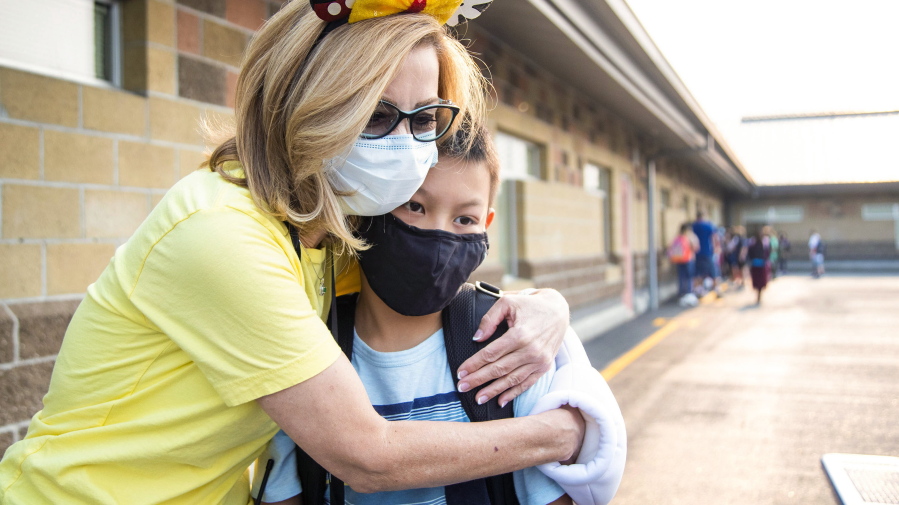BOISE, Idaho — Hospital facilities and public health agencies are scrambling to add capacity as the number of coronavirus cases continue to rise statewide. But many Idaho residents don’t seem to feel the same urgency.
Volunteers are helping with contract tracing at the Central District Health Department, and health education classrooms are being converted into COVID-19 treatment units in northern Idaho. On Thursday, some Idaho hospitals only narrowly avoided asking the state to enact “crisis standards of care” — where scarce health care resources are allotted to the patients most likely to benefit — thanks in part to statewide coordination.
Meanwhile, unmasked spectators sat shoulder-to-shoulder in the showing arena at the Western Idaho Fair this week as kids maneuvered livestock around the ring. At West Ada School District, Idaho’s largest school district, 21% of students had officially “opted out” of the district’s mask requirement before the first day of school ended on Thursday.
“Our forecast is bad, to put it real bluntly,” said Dr. Frank Johnson, chief medical officer for St. Luke’s Health System.
Coronavirus-related hospital admissions have been doubling every two weeks since July 24, he said. Thursday there were between 162 and 170 COVID-19 patients hospitalized in St. Luke’s facilities.
“If we take that over the next two weeks and double that, we’re in a real, real difficult state that is well above any of the prior peaks that we had,” Johnson said. “We don’t have room for those numbers to double.”
Neighboring states are in similar straits. St. Luke’s has been getting regular calls from overwhelmed facilities in Oregon, Washington and Nevada looking for places to send patients. Oregon has contracted with a private medical company to send “crisis teams” of nurses, respiratory therapists and paramedics to its hardest-hit hospitals in hopes of easing some of the load. Idaho’s public health leaders have requested help from FEMA, but the state is competing against others also requesting the same aid.
And because hospitalizations generally occur about two weeks after the patient is first infected with coronavirus, the state’s climbing number of positive tests could mean any help may not come soon enough for some patients. More than 1,000 newly confirmed cases were reported on Wednesday and the daily number of new cases has been trending steadily upward.
Hospitals and public health officials have frequent conference calls as they try to shuffle patients to the places where resources are still available. The calls are clinical in nature, but at times incredibly grim.
“One of our partners in the state earlier today hit the point where they had had a patient intubated down in their emergency department, needing to keep that patient alive as they were trying to find a bed for that patient because they couldn’t care for them there,” Johnson said. “They were thinking about who they could take off a ventilator so they could put that patient on a ventilator — that’s a crisis level of care. We were at that level today.”
It’s difficult, but understandable to see many Idaho residents acting like coronavirus isn’t a big deal, Johnson said.
“Most of our patients in our state here in Idaho are not going to require hospitalization for COVID,” Johnson said. “In terms of the proportion of the population, yeah, it’s not most people that are in that situation, so I get it that people don’t see that right in front of them.”
But it’s not just COVID-19 patients who will be affected by limited hospital capacity. On Thursday, as St. Luke’s was struggling to find beds for coronavirus patients across the state in need of ICU care, three new patients came in with strokes in need of the same beds.
“We’re having trouble and we will have trouble accommodating the needs of our community if they have an emergency,” Johnson said. “If a kid comes in with pediatric trauma and we’re stressed on space and capacity, we are going to have a hard time taking care of them.”
Last winter when hospitals were overwhelmed, masking and social distancing helped turn the tide. Now, with vaccination also available, the public can again help hospitals maintain capacity, he said. Roughly 98% of the COVID-19 patients in St. Luke’s ICU are unvaccinated.
“Regardless of their opinions on COVID, we want to make sure that we have capacity for them,” Johnson said.



